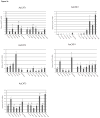SLC7 amino acid transporters of the yellow fever mosquito Aedes aegypti and their role in fat body TOR signaling and reproduction
- PMID: 22266018
- PMCID: PMC3322257
- DOI: 10.1016/j.jinsphys.2012.01.005
SLC7 amino acid transporters of the yellow fever mosquito Aedes aegypti and their role in fat body TOR signaling and reproduction
Abstract
Background: An important function of the fat body in adult female mosquitoes is the conversion of blood meal derived amino acids (AA) into massive amounts of yolk protein precursors. A highly efficient transport mechanism for AAs across the plasma membrane of the fat body trophocytes is essential in order to deliver building blocks for the rapid synthesis of large amounts of these proteins. This mechanism consists in part of AA transporter proteins from the solute carrier family. These transporters have dual function; they function as transporters and participate in the nutrient signal transduction pathway that is activated in the fat body after a blood meal. In this study we focused on the solute carrier 7 family (SLC7), a family of AA transporters present in all metazoans that includes members with strong substrate specificity for cationic AAs.
Methodology/principal findings: We identified 11 putative SLC7 transporters in the genome sequence of Aedes aegypti. Phylogenetic analysis puts five of these in the cationic AA transporter subfamily (CAT) and six in the heterodimeric AA transporter (HAT) subfamily. All 11 A. aegypti SLC7 genes are expressed in adult females. Expression profiles are dynamic after a blood meal. We knocked down six fat body-expressed SLC7 transporters using RNAi and found that these 'knockdowns' reduced AA-induced TOR signaling. We also determined the effect these knockdowns had on the number of eggs deposited following a blood meal.
Conclusions/significance: Our analysis stresses the importance of SLC7 transporters in TOR signaling pathway and mosquito reproduction.
Copyright © 2012 Elsevier Ltd. All rights reserved.
Figures






References
-
- Attardo GM, Hansen IA, Raikhel AS. Nutritional regulation of vitellogenesis in mosquitoes: implications for anautogeny. Insect biochemistry and molecular biology. 2005;35:661–675. - PubMed
-
- Attardo GM, Hansen IA, Shiao SH, Raikhel AS. Identification of two cationic amino acid transporters required for nutritional signaling during mosquito reproduction. The Journal of experimental biology. 2006;209:3071–3078. - PubMed
-
- Avruch J, Long XM, Spycher C, Han ZS, Rose AM, Muller F. TOR deficiency in C-elegans causes developmental arrest and intestinal atrophy by inhibition of mRNA translation. Current Biology. 2002;12:1448–1461. - PubMed
-
- Chomczynski P, Sacchi N. Single-step method of RNA isolation by acid guanidinium thiocyanate-phenol-chloroform extraction. Analytical biochemistry. 1987;162:156–159. - PubMed
Publication types
MeSH terms
Substances
Grants and funding
LinkOut - more resources
Full Text Sources
Miscellaneous

